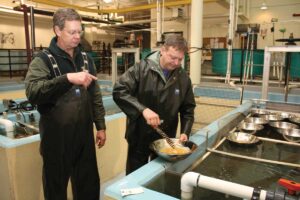Whether it’s a largemouth bass, Muskie or a trout, an Illinois angler may not realize that the fish reeled in from the depths of the water may not have originated there. In fact, it could be one of the millions of fish raised in the Illinois Hatchery System that supplements the fish population of Illinois water each year.
There are three hatcheries in the Illinois Hatchery System, which is part of the Illinois Department of Natural Resources (IDNR): LaSalle Hatchery in LaSalle County, Little Grassy Fish Hatchery in Williamson County and Jake Wolf Memorial Fish Hatchery in Mason County.
“It’s our job to provide those native, non-native and sport fish species that help to maintain, establish or restore fisheries across Illinois, whether it be in Lake Michigan, reservoirs, streams, or impoundments,” says Steve Krueger, manager at Jake Wolf.
In a perfect world, the waterways would be self-sustaining, but Kruger explains that doesn’t always work due to pollution, water manipulation, drought, habitat degradation, and invasive species like Asian carp or zebra mussels.
“We’re assisting Mother Nature as best we can,” Krueger says.

Photo Credit: Michelle McNeal
The Jake Wolf hatchery is the largest of the three in Illinois, and it is unique because it can produce cold, cool and warm water fish species due to its location in the Sand Ridge State Forest.
The hatchery has access to the Mahomet Aquifer, which provides 54-degree Fahrenheit water year-round for the cold water species. Then there’s the Solar Pond that gets warmed up by the sun for the warm water fish. The two water sources can be mixed for a perfect temperature for the cool water species.
More than a dozen fish species are hatched at Jake Wolf, and it is expected to produce more than 2 million fish this year with a large portion going into Illinois state and public waters.
The hatchery keeps busy year-round with fish continuously going from incubation, to start tanks, raceways, ponds and then released into Illinois water. Each species of fish is different, and there are different processes to raising each kind.
“We are constantly moving fish through our little fish factory,” Krueger comments. “There’s an art and a science to culturing fish.”
It all starts with an egg. Getting the eggs depends on the species. Rainbow and brown trout eggs are mailed in from the Fish and Wildlife Service. Steelhead trout eggs are picked up in Indiana. Other species are spawned at the hatchery.
In March, district biologists and hatchery workers go to nearby Spring Lake to start spawning Muskie. Trap nets are set, and the adult Muskie are brought back to the hatchery and separated by gender. Once the females are ready to spawn, milt is taken from the males and eggs from the females.
“We’ll mix them in a bowl, stir them up with a feather and bada bing, we’re proud parents,” Krueger says.
The fertilized eggs then go to incubation. The eggs are topically disinfected and, depending on the species, are placed into heath trays or jar incubators.
Krueger explains that heath trays are like a chest of drawers for fish eggs. Water comes in the top tray and flows over the eggs. Oxygen comes from the running water. The eggs need a consistent temperature and fresh oxygen all the time. The jar incubators are a little different. The eggs are placed in a jar and gently roll around in water. Some fish may hatch in three or four days, and others hatch in two weeks.
“This is our attempt to duplicate what Mother Nature provides in the wild,” Krueger explains.
From incubation, the fish move to the start tank room. This industrial sized room is filled with 56 large, rectangular tanks where the fish are presented with the perfect diet to help them grow.
Krueger says that they keep the fish in the start tank room as long as possible because that’s where they find the most growth. Eventually these fish outgrow the tanks and are moved outside to the raceways.
The duration that the fish stay at the hatchery can be short. “It depends on the species and the size that we are trying to get them,” Krueger explains. Some fish will only be there four to five months before they reach the right size, and then most are distributed to Illinois waters.
Whether in the start tank room or in the ponds, there are always fish being raised at the hatchery, but right now, fish aren’t the only residents at Jake Wolf. Mussels are there too.
Diane Shasteen, an assistant manager at the hatchery, heads a new program attempting to repopulate and save species of mussels in Illinois. Before coming to the hatchery, Shasteen worked for the Illinois Natural History Survey where she took part in a statewide mussel survey.

This survey showed the population and species of mussels have been cut drastically across the state.
“Ever since I started that project, I’ve been infatuated with mussels,” Shasteen says. “They are just really cool critters. Hopefully we’ll be able to propagate and culture some mussels here and bring back some of the species we’re losing.”
According to IDNR, more than half of the 80 species of mussels native to Illinois are currently threatened, endangered or extinct. “Hopefully we can at least keep the half that we still have,” Shasteen says.
Shasteen credits pollution, siltation, and the creation of dams or anything impeding waterflow and the movement of fish as the main problems that impact mussels. The issue is that mussels are filter feeders and take in whatever is in the water, essentially wiping them out.
“Mussels are really important to the freshwater ecosystem,” Shasteen explains. “We call them the livers of the river… They filter everything. Therefore, they’re very susceptible to any kind of pollution that we have.”
The project is brand new, so the main objective is to see if the mussels can survive at the hatchery. Local adult mussels were brought in to see if they can thrive. So far, they have.
Juvenile mussels from Genoa National Park Fish Hatchery in Wisconsin have been brought in to see if they can grow into adulthood. If this is successful, the next step is to propagate the mussels.
This is just the beginning of Jake Wolf’s Aquatic Biodiversity Program. At the hatchery, a goal is to help save threatened and endangered fish species as well as mussels. “That’s just another avenue that we’ll try in the future… We’re just starting with the mussels to see how that goes,” Shasteen says. “Mussels aren’t your koala bear, they aren’t your big attractive species that people really care about.”
Whether they are saving the mussels or raising fish, Krueger credits the workers for the hatchery’s success.
“What’s cool about Jake Wolf is the crew that we have here. They are super dedicated, knowledgeable and passionate,” Krueger says. “It’s the crew that works here, the teamwork that they show, and their passion for fish culture and the outdoors that makes this place so successful. I can’t emphasize that enough… The anglers of Illinois owe them a tremendous debt.”









